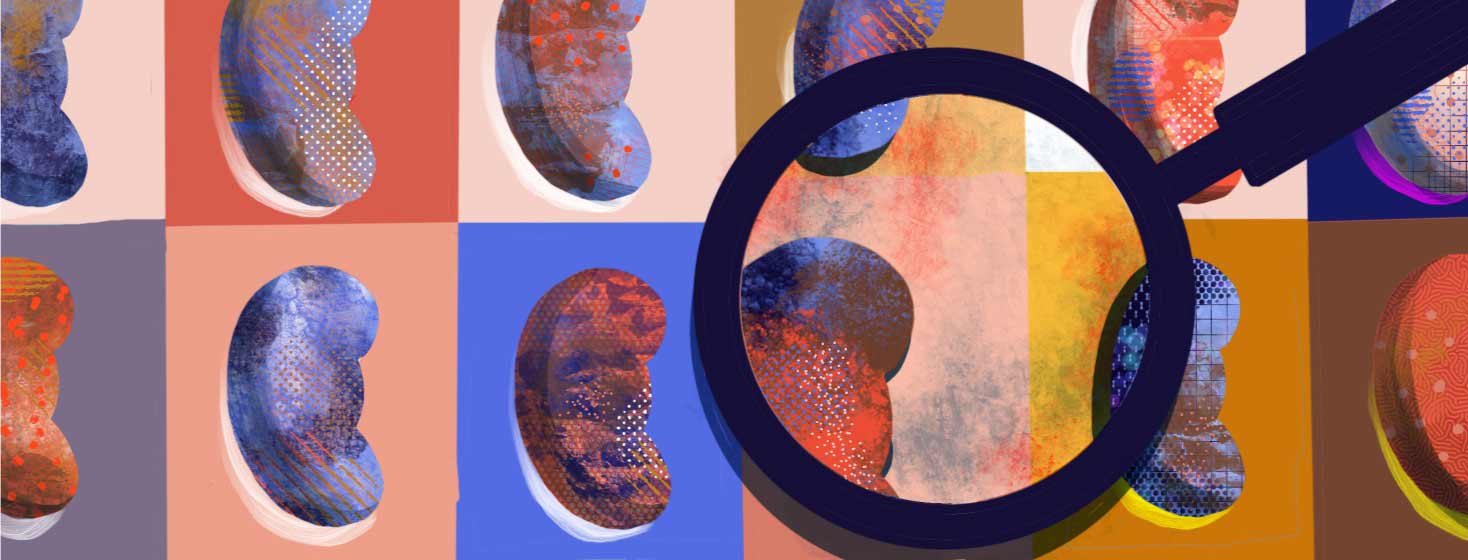Signs and Symptoms of Rare Kidney Diseases
Reviewed by: HU Medical Review Board | Last reviewed: February 2023 | Last updated: July 2023
Rare kidney diseases can affect people of all ages and backgrounds. There are more than 150 different types of these diseases, and each one has unique features. Even the same rare kidney disease can look different in different people due to a variety of factors.1-3
There are some common trends in symptoms that relate to overall kidney function. But several diseases affect other areas of the body too.3,4
Rare kidney disease can go unnoticed
About 90 percent of people do not even know they have a rare kidney disease before they are diagnosed. Symptoms may be mild enough that they go unnoticed.5,6
It is fairly common for a rare kidney disease to be found incidentally. This means the disease was found during a routine screening or when looking for something else. For example, cysts or kidney damage may show up on images of the abdomen that were taken after a person reported abdominal pain. This may lead to a diagnosis of polycystic kidney disease (PKD).5,6
Common abnormal lab findings
There are common lab tests that might point toward a rare kidney disease diagnosis. Abnormal results on the following tests can be a sign. Many of these labs are drawn during routine doctor’s appointments or to monitor other, non-kidney related health issues:3-5,7
- Electrolytes – These include sodium, potassium, phosphorus, and calcium.
- Protein levels
- Estimated glomerular filtration rate (eGFR), creatinine, or blood urea nitrogen (BUN) – These are all markers of kidney function.
- Urinalysis – This is a study of a person’s urine to look for infection, protein, or blood.
- Parathyroid hormone (PTH) – This is a hormone that plays a role in regulating kidney functions.
Common symptoms of rare kidney diseases
Although each person’s case is different, there are some common signs and symptoms of kidney damage. Sometimes these take a while to notice, and they can be mild at first. They may include:3-7
- High blood pressure – The kidneys help regulate blood pressure, fluid balance, and the hormones that control them. When kidneys are damaged, high blood pressure may be an early sign.
- Fatigue – Because the kidney cannot filter waste, toxins can build up in the body. These can cause fatigue or extreme tiredness.
- Dark urine – Some rare kidney diseases cause bleeding, but sometimes this blood can be hard to see with the naked eye. Urine with visible blood may look red, brown, or darker than usual.
- Foamy urine – If the kidneys are damaged, proteins can leak out from the body and escape through the urine. This makes urine look frothy, foamy, or bubbly.
- Changes in urine frequency or amount – There are many reasons why the number of times you have to go to the bathroom or how much you go may change. Some of these are related to aging or underlying infections. However, these changes can also be a sign of kidney damage from a rare disease.
- Cramping muscles – When the kidneys cannot regulate electrolytes, such as calcium and potassium, muscles may start to cramp.
- Itchy or dry skin – The kidneys play a big role in regulating mineral balance and bone health. When this balance is off due to kidney damage, skin issues like itching or dryness can occur.
- Swelling – When protein is lost in the urine due to kidney damage, fluid can build up in the body. This can lead to swelling in unusual places, like the face or around the eyes. Damaged kidneys also have a hard time regulating salt balance. This can lead to swelling of the feet or ankles.
- Back pain – The kidneys are in the lower abdomen, closer to the back. In some cases, general lower back or side pain may be a sign of a disease such as PKD.
- Changes in appetite – Toxin buildup, electrolyte changes, and other effects of kidney damage can lead to stomach discomfort and lack of appetite.
This is not a complete list of all the potential symptoms of kidney damage or rare kidney diseases. The kidneys play many roles in the body. When they are damaged, the symptoms can be wide-reaching. If you are concerned about your risk, talk with your doctor.
Disease-specific symptoms
In addition to the general symptoms of kidney damage, some rare kidney diseases can have unique symptoms. Here are a few examples:3-11
- Complement 3 glomerulopathy (C3G) – Recurrent infections, vision issues, or abnormal fat cell distribution (where some areas of the body are thin and other areas have excess fat)
- IgA nephropathy (IgAN) – Symptoms that get worse after a recent illness (like respiratory illness) or rash on the legs and buttocks
- PKD – Cysts in other areas of the body like the liver or pancreas
- Alport syndrome – Hearing or vision problems
- Fabry disease – Heart and nervous system issues
- Goodpasture’s syndrome – Lung damage that can lead to coughing up blood
- Amyloidosis – Enlarged tongue, easy bruising, or purple patches around the eyes
As with the general symptoms, this is not a complete list of all the unique signs of individual rare kidney diseases. If you do notice any signs of kidney damage, let your doctor know. Many of the initial tests are quick and easy to complete. Undiagnosed or untreated kidney disease can become life-threatening. Early detection and diagnosis is key.4

Join the conversation